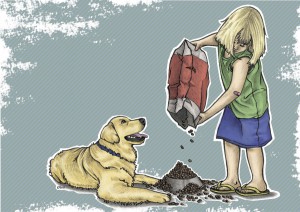 Like the last couple columns, this one is in two parts. I told you I was going to be more organized last time but because I’m a hypocrite and promise breaker I just can’t stay on one topic. I also think I should just shell out the co-pay for the ADHD formal diagnosis. That might make my life easier. I joke about it enough. It would be cool to be certifiable and get a bunch of people off my back at the same time.
Like the last couple columns, this one is in two parts. I told you I was going to be more organized last time but because I’m a hypocrite and promise breaker I just can’t stay on one topic. I also think I should just shell out the co-pay for the ADHD formal diagnosis. That might make my life easier. I joke about it enough. It would be cool to be certifiable and get a bunch of people off my back at the same time.
Man, the summer took a lot out of me. I’m a parent and I can’t afford camp the whole summer so I had to run what I call “MommyKampf” for four weeks. The activities vary from a trip to the Museum of Art and Design (one of the greatest museums in the city, by me) and a picnic lunch in Central Park to lying on the dirty carpet in the living room sorting buttons and eating the leftover Halloween candy which was just found in a keepsake box meant for first locks of hair and pre-school paintings. Kampf, like any poorly run camp, is subject to the whims of its director. If it rains, we watch too much television and fight. If it’s too hot, we fight and watch too much television. Kampf is not perfect but it’s our camp and we don’t have to bother ourselves with updating a fancy website chock full of glowing testimonials. But since you asked, here’s a quote from one of our loyal campers: “It was pretty fun. I mean, sometimes it was super boring. But I liked when we did stuff. I liked hanging out with the dog and watching television. That was the best.”
Here’s what I learned at camp and what I am here to teach you this column. Teach your kids stuff. I don’t mean why Venus is Hotter than Mercury (totally true, dude). I mean teach them how to do useful stuff around the house. As MommyKamf ran on I got a little snappy and would yell out commands I remembered from my youth such as “Make Your Beds, Load the Dishwasher! Empty the Trash Cans!” At the end of the day, none of these chores were done and I demanded an explanation. I was met with blank faces. Then it hit me. My kids didn’t know how to do anything around the house. My bad. I had been too busy explaining the lifecycle of a walrus. Instead I should have taught them to stop and smell the laundry.
So this past summer I found myself giving morning classes in Home Maintenance. The bedmaking class was the most successful. They adopted the “make it while in it” approach with enthusiasm. I also threw in the “put your pajamas under your pillow” bonus lesson which they also seemed to enjoy. We practiced our new skills every morning. After that routine was established I began offering a whole host of electives: Feed the Dog (in two easy steps), Laundry Sorting 101, Glass Cleaning (with emphasis on mirrors). All classes went remarkably well and when put in weekly rotation everyone seemed a whole lot happier knowing what was expected of them.
Kids actually like responsibility, and they also like being rewarded for it. Some parents do sticker charts and allowances. I prefer to borrow the old school phrase “earn your keep.” In the New York Magazine article about how parents hate their lives (I don’t, by the way, but I act like I do to get dates) it wasn’t too long ago that people had kids to get a little help around the house/farm/family business. Now, kids are like safety deposit boxes in which parents cram unfulfilled dreams, not too mention a ton of money to teach them stuff they never learned (e.g. karate, macrobiotic cooking, and Mandarin). Because we have a limited budget we’ve opted out of classes and substituted in “duties.” I decided not to call our new activities “chores.” “Chores” has a ring of medieval drudgery to it and “do your duties” has alternate connotation that any seven-year-old can appreciate. I even get the giggles when I shout it from my post at the kitchen sink. Try it with me. “DO YOUR DUTIES!” Fun, right?
Summary. Teach your kids stuff that helps you around the house. Everyone will be happier or at least you will be. And kid knows when mommy is happy she makes cookies or orders in Thai food. Sometimes she’ll even drink two beers at dinner and forget to make you brush your teeth. End of segment.
Segment two stems from the heaviest of hearts. Just as we were hitting our stride in the summer, we got sucker punched. A tragic sudden death—our beloved Gramma, my husband’s mother—brought us to our knees. The loss was epic for us all. She was a loving mother, a non-judgmental mother-in-law and the model grandmother. She could weather a 45-minute phone call from a toddler or a three-hour bounce house birthday party without a single complaint.
When death comes without warning, before mourning can begin, the shock must dissipate. This is a very painful process akin to the chemical-like burning experienced when frostbite toes thaw. After they hit room temperature, our hearts then had to reconcile the tragic loss of a mother and a grandmother so deeply beloved. It sucked big time. It was and is a long and involved process.
Rumi said “The cure for the pain is in the pain.” And the pain is very real. When you lose someone dear to you, your chest feels constricted as if your heart is encased in concrete and has forgotten how to do its job. We were lucky. We had great support of family and friends. Sometimes people can feel like warm blankets wrapping you up, keeping you safe and warm. I have never been the one inside the blanket before. I was always the outsider, tentatively offering a weak “if there’s anything I can do, please call.” Death is one of the few things that connect us all. But if you haven’t experienced a significant loss it’s hard to know how to help those who are suffering.
Having been a mourner I thought I’d write this column about the crap you should not do to help those left behind. I’ll also add the stuff that helps too.
Here’s stuff that I thought was useless and sometimes maddening: Any unsolicited therapy type advice. (This goes triple if you are just a business associate.) If you have suffered a loss, and did most of your mourning while watching Doris Day movies don’t presume what worked for you will work for the mourner. Stop telling us how to mourn. I’m serious. Stop talking. Our hearts are aching and you are making us mad. Offer your sympathy then send a plate of cookies to the house later on in the week.
The “better place” line. Maybe, but who the hell really knows? If it was a sudden death, it probably isn’t true. In our case, it’s unimaginable. She was adored by friends and family and had a great dog/house/car. She loved her life. Where’s better than that?
Telling the deceased grandkids some crazy story about where their Gramma is now: We told our kids that Gramma is dead. She’s not coming back. Then we answered questions, which were few. If you tell a four and seven-year-old that Gramma is now a star in the sky looking over them every night to make sure they are good girls and boys you will have to field the following questions:
Which star is she? Can she see when it’s raining out? Stars die. When will her star die? When it does, will there be another funeral in space? Does she know the moon? Do they have parties? That’s a lot of questions when you’re dealing with a lot of details already. Don’t offer explanations to the kids at the service. You might think you’re being helpful, but you’re not. Let the parents deal with the kids in their own way. That being said, do ask them about their Barbies or Silly Bandz.
Here are some things that were very helpful during the difficult time: Small diversions. Babies are great. So are puppies and invitations to weddings. Anything life affirming. Flowers, not so much. If you want to send flowers, send money instead to the dedicated charity. My mother-in-law’s charity was the ASPCA and when someone donates, we get a card with puppies and kitties looking out a window. This makes me smile.
Food later on in the week. You get tons of food in the beginning and then nothing. It’s nice if it’s spaced out a little. The amount doesn’t matter. Twenty servings of lasagna are nice but so is a loaf of banana bread. Seriously. It’s a huge comfort to know people are still thinking about you when you’re still thinking about your loss.
Space. If you don’t get called back or experience erratic behavior from a mourner, do not assume you did something wrong that needs apologizing or processing. Lower your expectations. Mourning takes time. Check in every once in a while but be gentle. I’m sure you know this intuitively but everyone mourns in their own way so it bears repeating. I often write this column as if I’m talking to a room full of idiots. I can’t help it, I’m a bitter jaded hypocrite. Not that you could tell by this month’s column. Death has dwarfed my tendency to do one thing and say another. Life is precious. Hug your family and friends while you’re all still here.
Cripes. Got all soft on you there. Summary: 1. Teach your kids to do stuff so you don’t have to. 2. Life is short. See you next time.

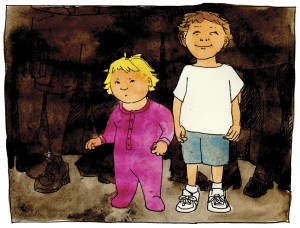
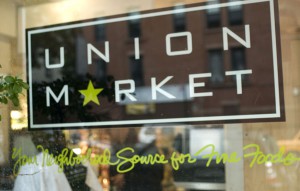



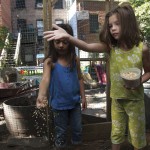

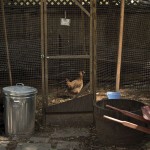
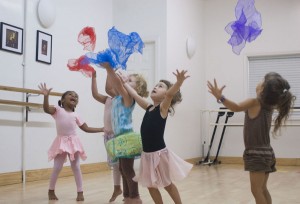
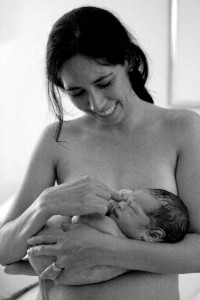

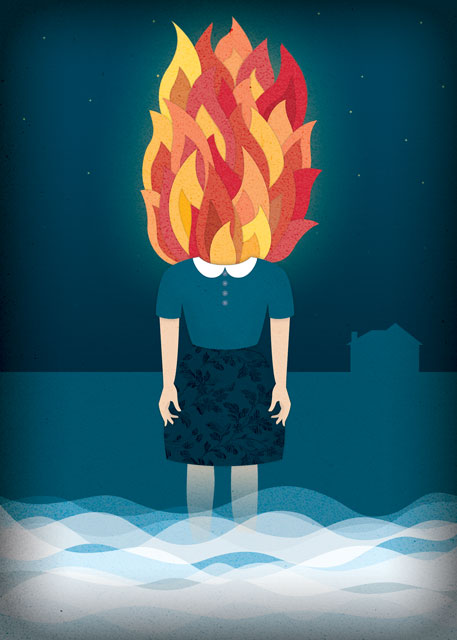 My sister’s house was burgled last week. Someone broke in through the window in front of the kitchen sink. They just smashed it right in, she said over the phone, kind of neatly, right into the sink. The cops told her it was one of the tidiest burglaries they had ever seen. They joked that the burglar must have been a pretty nice guy. It looked like he even took off his shoes, they said. Too bad for him that my sister’s a real kook. She doesn’t own a TV. She doesn’t have any jewelry but her wedding ring. She doesn’t even have a full set of silverware. My wife asked her one time, “Why don’t you just buy a TV, even a little one, for Tyler.” My sister said “I don’t want to be reminded that we’re all going to hell for the same reasons.”
My sister’s house was burgled last week. Someone broke in through the window in front of the kitchen sink. They just smashed it right in, she said over the phone, kind of neatly, right into the sink. The cops told her it was one of the tidiest burglaries they had ever seen. They joked that the burglar must have been a pretty nice guy. It looked like he even took off his shoes, they said. Too bad for him that my sister’s a real kook. She doesn’t own a TV. She doesn’t have any jewelry but her wedding ring. She doesn’t even have a full set of silverware. My wife asked her one time, “Why don’t you just buy a TV, even a little one, for Tyler.” My sister said “I don’t want to be reminded that we’re all going to hell for the same reasons.”